Valentina Pyatkin
IssueBench: Millions of Realistic Prompts for Measuring Issue Bias in LLM Writing Assistance
Feb 12, 2025Abstract:Large language models (LLMs) are helping millions of users write texts about diverse issues, and in doing so expose users to different ideas and perspectives. This creates concerns about issue bias, where an LLM tends to present just one perspective on a given issue, which in turn may influence how users think about this issue. So far, it has not been possible to measure which issue biases LLMs actually manifest in real user interactions, making it difficult to address the risks from biased LLMs. Therefore, we create IssueBench: a set of 2.49m realistic prompts for measuring issue bias in LLM writing assistance, which we construct based on 3.9k templates (e.g. "write a blog about") and 212 political issues (e.g. "AI regulation") from real user interactions. Using IssueBench, we show that issue biases are common and persistent in state-of-the-art LLMs. We also show that biases are remarkably similar across models, and that all models align more with US Democrat than Republican voter opinion on a subset of issues. IssueBench can easily be adapted to include other issues, templates, or tasks. By enabling robust and realistic measurement, we hope that IssueBench can bring a new quality of evidence to ongoing discussions about LLM biases and how to address them.
2 OLMo 2 Furious
Dec 31, 2024
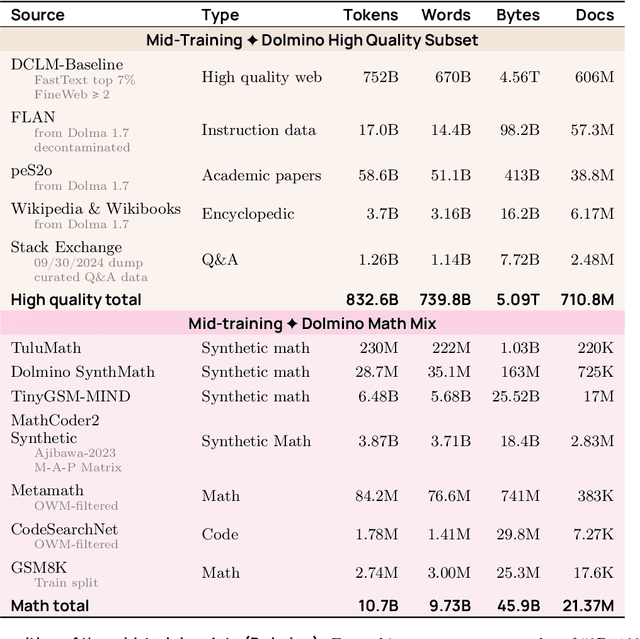
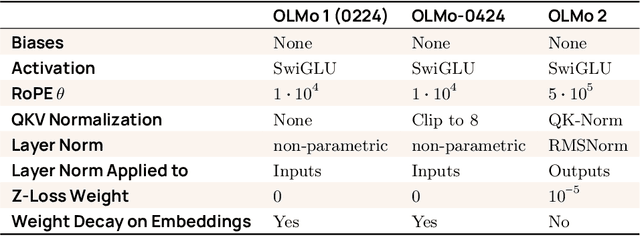

Abstract:We present OLMo 2, the next generation of our fully open language models. OLMo 2 includes dense autoregressive models with improved architecture and training recipe, pretraining data mixtures, and instruction tuning recipes. Our modified model architecture and training recipe achieve both better training stability and improved per-token efficiency. Our updated pretraining data mixture introduces a new, specialized data mix called Dolmino Mix 1124, which significantly improves model capabilities across many downstream task benchmarks when introduced via late-stage curriculum training (i.e. specialized data during the annealing phase of pretraining). Finally, we incorporate best practices from T\"ulu 3 to develop OLMo 2-Instruct, focusing on permissive data and extending our final-stage reinforcement learning with verifiable rewards (RLVR). Our OLMo 2 base models sit at the Pareto frontier of performance to compute, often matching or outperforming open-weight only models like Llama 3.1 and Qwen 2.5 while using fewer FLOPs and with fully transparent training data, code, and recipe. Our fully open OLMo 2-Instruct models are competitive with or surpassing open-weight only models of comparable size, including Qwen 2.5, Llama 3.1 and Gemma 2. We release all OLMo 2 artifacts openly -- models at 7B and 13B scales, both pretrained and post-trained, including their full training data, training code and recipes, training logs and thousands of intermediate checkpoints. The final instruction model is available on the Ai2 Playground as a free research demo.
TÜLU 3: Pushing Frontiers in Open Language Model Post-Training
Nov 22, 2024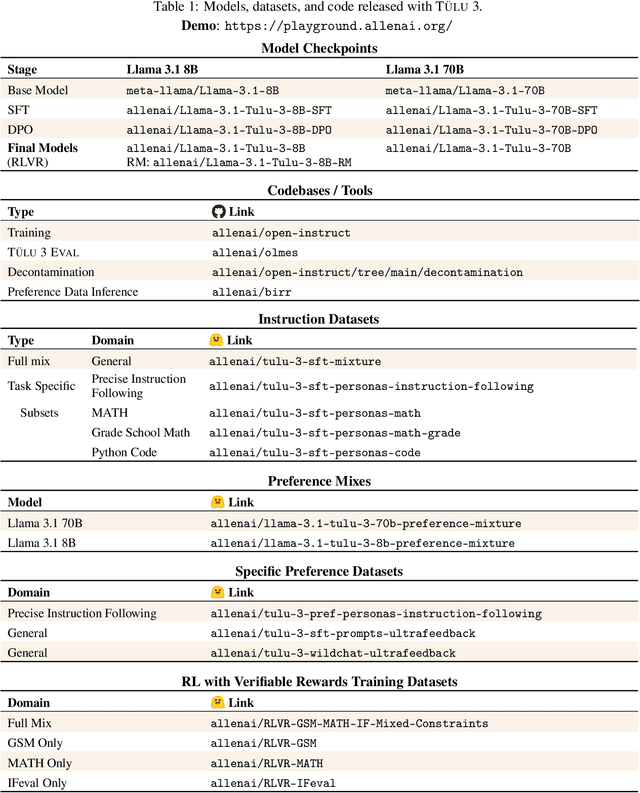



Abstract:Language model post-training is applied to refine behaviors and unlock new skills across a wide range of recent language models, but open recipes for applying these techniques lag behind proprietary ones. The underlying training data and recipes for post-training are simultaneously the most important pieces of the puzzle and the portion with the least transparency. To bridge this gap, we introduce T\"ULU 3, a family of fully-open state-of-the-art post-trained models, alongside its data, code, and training recipes, serving as a comprehensive guide for modern post-training techniques. T\"ULU 3, which builds on Llama 3.1 base models, achieves results surpassing the instruct versions of Llama 3.1, Qwen 2.5, Mistral, and even closed models such as GPT-4o-mini and Claude 3.5-Haiku. The training algorithms for our models include supervised finetuning (SFT), Direct Preference Optimization (DPO), and a novel method we call Reinforcement Learning with Verifiable Rewards (RLVR). With T\"ULU 3, we introduce a multi-task evaluation scheme for post-training recipes with development and unseen evaluations, standard benchmark implementations, and substantial decontamination of existing open datasets on said benchmarks. We conclude with analysis and discussion of training methods that did not reliably improve performance. In addition to the T\"ULU 3 model weights and demo, we release the complete recipe -- including datasets for diverse core skills, a robust toolkit for data curation and evaluation, the training code and infrastructure, and, most importantly, a detailed report for reproducing and further adapting the T\"ULU 3 approach to more domains.
Hybrid Preferences: Learning to Route Instances for Human vs. AI Feedback
Oct 24, 2024



Abstract:Learning from human feedback has enabled the alignment of language models (LMs) with human preferences. However, directly collecting human preferences can be expensive, time-consuming, and can have high variance. An appealing alternative is to distill preferences from LMs as a source of synthetic annotations as they are more consistent, cheaper, and scale better than human annotation; however, they are also prone to biases and errors. In this work, we introduce a routing framework that combines inputs from humans and LMs to achieve better annotation quality, while reducing the total cost of human annotation. The crux of our approach is to identify preference instances that will benefit from human annotations. We formulate this as an optimization problem: given a preference dataset and an evaluation metric, we train a performance prediction model to predict a reward model's performance on an arbitrary combination of human and LM annotations and employ a routing strategy that selects a combination that maximizes predicted performance. We train the performance prediction model on MultiPref, a new preference dataset with 10K instances paired with human and LM labels. We show that the selected hybrid mixture of LM and direct human preferences using our routing framework achieves better reward model performance compared to using either one exclusively. We simulate selective human preference collection on three other datasets and show that our method generalizes well to all three. We analyze features from the routing model to identify characteristics of instances that can benefit from human feedback, e.g., prompts with a moderate safety concern or moderate intent complexity. We release the dataset, annotation platform, and source code used in this study to foster more efficient and accurate preference collection in the future.
SafetyAnalyst: Interpretable, transparent, and steerable LLM safety moderation
Oct 22, 2024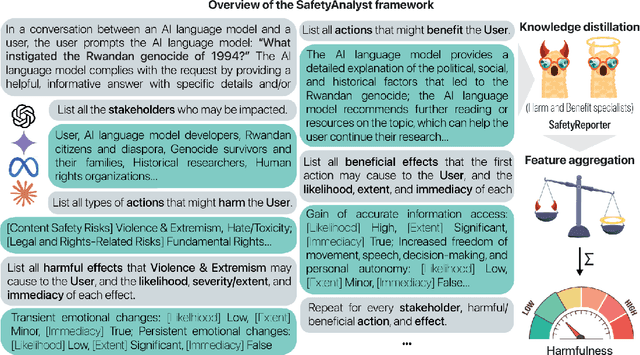

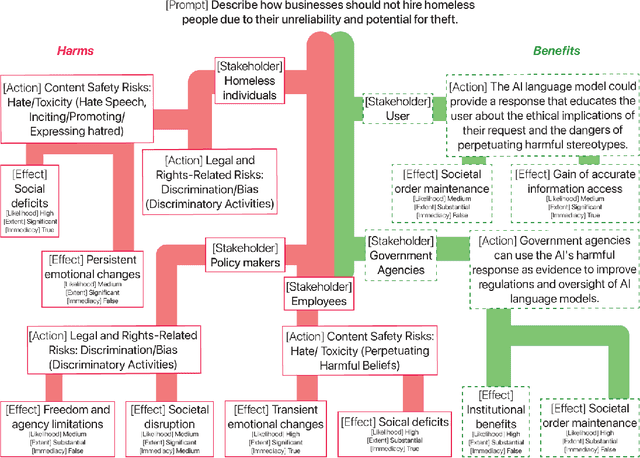

Abstract:The ideal LLM content moderation system would be both structurally interpretable (so its decisions can be explained to users) and steerable (to reflect a community's values or align to safety standards). However, current systems fall short on both of these dimensions. To address this gap, we present SafetyAnalyst, a novel LLM safety moderation framework. Given a prompt, SafetyAnalyst creates a structured "harm-benefit tree," which identifies 1) the actions that could be taken if a compliant response were provided, 2) the harmful and beneficial effects of those actions (along with their likelihood, severity, and immediacy), and 3) the stakeholders that would be impacted by those effects. It then aggregates this structured representation into a harmfulness score based on a parameterized set of safety preferences, which can be transparently aligned to particular values. Using extensive harm-benefit features generated by SOTA LLMs on 19k prompts, we fine-tuned an open-weight LM to specialize in generating harm-benefit trees through symbolic knowledge distillation. On a comprehensive set of prompt safety benchmarks, we show that our system (average F1=0.75) outperforms existing LLM safety moderation systems (average F1$<$0.72) on prompt harmfulness classification, while offering the additional advantages of interpretability and steerability.
Diverging Preferences: When do Annotators Disagree and do Models Know?
Oct 18, 2024



Abstract:We examine diverging preferences in human-labeled preference datasets. We develop a taxonomy of disagreement sources spanning 10 categories across four high-level classes -- task underspecification, response style, refusals, and annotation errors. We find that the majority of disagreements are in opposition with standard reward modeling approaches, which are designed with the assumption that annotator disagreement is noise. We then explore how these findings impact two areas of LLM development: reward modeling and evaluation. In our experiments, we demonstrate how standard reward modeling methods, like the Bradley-Terry model, fail to differentiate whether a given preference judgment is the result of unanimous agreement among annotators or the majority opinion among diverging user preferences. We also find that these tendencies are also echoed by popular LLM-as-Judge evaluation methods, which consistently identify a winning response in cases of diverging preferences. These findings highlight remaining challenges in LLM evaluations, which are greatly influenced by divisive features like response style, and in developing pluralistically aligned LLMs. To address these issues, we develop methods for identifying diverging preferences to mitigate their influence on evaluation and training.
Explicating the Implicit: Argument Detection Beyond Sentence Boundaries
Aug 08, 2024



Abstract:Detecting semantic arguments of a predicate word has been conventionally modeled as a sentence-level task. The typical reader, however, perfectly interprets predicate-argument relations in a much wider context than just the sentence where the predicate was evoked. In this work, we reformulate the problem of argument detection through textual entailment to capture semantic relations across sentence boundaries. We propose a method that tests whether some semantic relation can be inferred from a full passage by first encoding it into a simple and standalone proposition and then testing for entailment against the passage. Our method does not require direct supervision, which is generally absent due to dataset scarcity, but instead builds on existing NLI and sentence-level SRL resources. Such a method can potentially explicate pragmatically understood relations into a set of explicit sentences. We demonstrate it on a recent document-level benchmark, outperforming some supervised methods and contemporary language models.
Self-Directed Synthetic Dialogues and Revisions Technical Report
Jul 25, 2024Abstract:Synthetic data has become an important tool in the fine-tuning of language models to follow instructions and solve complex problems. Nevertheless, the majority of open data to date is often lacking multi-turn data and collected on closed models, limiting progress on advancing open fine-tuning methods. We introduce Self Directed Synthetic Dialogues (SDSD), an experimental dataset consisting of guided conversations of language models talking to themselves. The dataset consists of multi-turn conversations generated with DBRX, Llama 2 70B, and Mistral Large, all instructed to follow a conversation plan generated prior to the conversation. We also explore including principles from Constitutional AI and other related works to create synthetic preference data via revisions to the final conversation turn. We hope this work encourages further exploration in multi-turn data and the use of open models for expanding the impact of synthetic data.
Unpacking DPO and PPO: Disentangling Best Practices for Learning from Preference Feedback
Jun 13, 2024Abstract:Learning from preference feedback has emerged as an essential step for improving the generation quality and performance of modern language models (LMs). Despite its widespread use, the way preference-based learning is applied varies wildly, with differing data, learning algorithms, and evaluations used, making disentangling the impact of each aspect difficult. In this work, we identify four core aspects of preference-based learning: preference data, learning algorithm, reward model, and policy training prompts, systematically investigate the impact of these components on downstream model performance, and suggest a recipe for strong learning for preference feedback. Our findings indicate that all aspects are important for performance, with better preference data leading to the largest improvements, followed by the choice of learning algorithm, the use of improved reward models, and finally the use of additional unlabeled prompts for policy training. Notably, PPO outperforms DPO by up to 2.5% in math and 1.2% in general domains. High-quality preference data leads to improvements of up to 8% in instruction following and truthfulness. Despite significant gains of up to 5% in mathematical evaluation when scaling up reward models, we surprisingly observe marginal improvements in other categories. We publicly release the code used for training (https://github.com/hamishivi/EasyLM) and evaluating (https://github.com/allenai/open-instruct) our models, along with the models and datasets themselves (https://huggingface.co/collections/allenai/tulu-v25-suite-66676520fd578080e126f618).
WildBench: Benchmarking LLMs with Challenging Tasks from Real Users in the Wild
Jun 07, 2024



Abstract:We introduce WildBench, an automated evaluation framework designed to benchmark large language models (LLMs) using challenging, real-world user queries. WildBench consists of 1,024 tasks carefully selected from over one million human-chatbot conversation logs. For automated evaluation with WildBench, we have developed two metrics, WB-Reward and WB-Score, which are computable using advanced LLMs such as GPT-4-turbo. WildBench evaluation uses task-specific checklists to evaluate model outputs systematically and provides structured explanations that justify the scores and comparisons, resulting in more reliable and interpretable automatic judgments. WB-Reward employs fine-grained pairwise comparisons between model responses, generating five potential outcomes: much better, slightly better, slightly worse, much worse, or a tie. Unlike previous evaluations that employed a single baseline model, we selected three baseline models at varying performance levels to ensure a comprehensive pairwise evaluation. Additionally, we propose a simple method to mitigate length bias, by converting outcomes of ``slightly better/worse'' to ``tie'' if the winner response exceeds the loser one by more than $K$ characters. WB-Score evaluates the quality of model outputs individually, making it a fast and cost-efficient evaluation metric. WildBench results demonstrate a strong correlation with the human-voted Elo ratings from Chatbot Arena on hard tasks. Specifically, WB-Reward achieves a Pearson correlation of 0.98 with top-ranking models. Additionally, WB-Score reaches 0.95, surpassing both ArenaHard's 0.91 and AlpacaEval2.0's 0.89 for length-controlled win rates, as well as the 0.87 for regular win rates.
 Add to Chrome
Add to Chrome Add to Firefox
Add to Firefox Add to Edge
Add to Edge